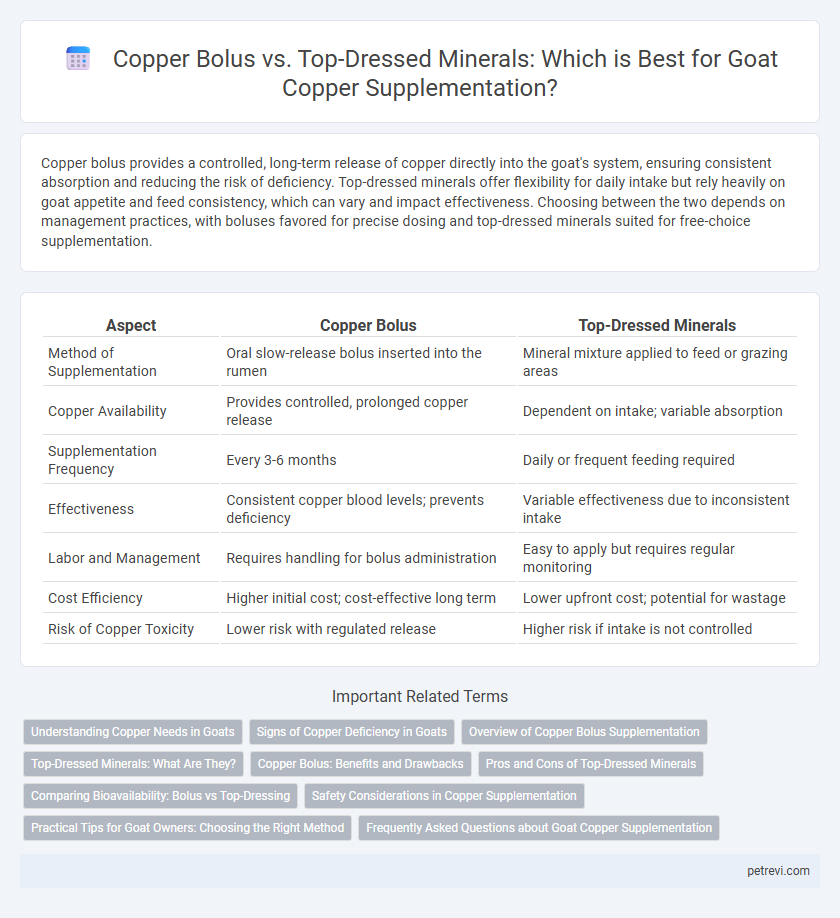Copper bolus provides a controlled, long-term release of copper directly into the goat's system, ensuring consistent absorption and reducing the risk of deficiency. Top-dressed minerals offer flexibility for daily intake but rely heavily on goat appetite and feed consistency, which can vary and impact effectiveness. Choosing between the two depends on management practices, with boluses favored for precise dosing and top-dressed minerals suited for free-choice supplementation.
Table of Comparison
| Aspect | Copper Bolus | Top-Dressed Minerals |
|---|---|---|
| Method of Supplementation | Oral slow-release bolus inserted into the rumen | Mineral mixture applied to feed or grazing areas |
| Copper Availability | Provides controlled, prolonged copper release | Dependent on intake; variable absorption |
| Supplementation Frequency | Every 3-6 months | Daily or frequent feeding required |
| Effectiveness | Consistent copper blood levels; prevents deficiency | Variable effectiveness due to inconsistent intake |
| Labor and Management | Requires handling for bolus administration | Easy to apply but requires regular monitoring |
| Cost Efficiency | Higher initial cost; cost-effective long term | Lower upfront cost; potential for wastage |
| Risk of Copper Toxicity | Lower risk with regulated release | Higher risk if intake is not controlled |
Understanding Copper Needs in Goats
Goats have specific copper requirements that vary based on breed, age, and diet, making precise supplementation essential to prevent deficiencies or toxicity. Copper boluses deliver a controlled, sustained release of copper directly to the animal's rumen, ensuring consistent absorption over time. In contrast, top-dressed minerals rely on voluntary intake and may result in uneven copper consumption, potentially compromising overall herd health and growth performance.
Signs of Copper Deficiency in Goats
Signs of copper deficiency in goats include hair depigmentation, anemia, poor growth, and increased susceptibility to infections due to impaired immune function. Copper bolus supplementation provides a controlled, long-lasting copper release directly to the rumen, enhancing bioavailability and preventing deficiency symptoms more effectively than top-dressed minerals, which may suffer from inconsistent intake. Monitoring these clinical signs alongside blood copper levels ensures timely intervention and optimal goat health management.
Overview of Copper Bolus Supplementation
Copper bolus supplementation for goats provides a controlled and sustained release of copper directly into the rumen, ensuring consistent bioavailability over several months. This method minimizes the risk of copper toxicity compared to injectable or free-choice mineral supplements by maintaining safe copper levels in the bloodstream. Effective copper bolus formulations are crucial in preventing deficiency-related issues such as anemia, poor growth, and compromised immune function in goats.
Top-Dressed Minerals: What Are They?
Top-dressed minerals for goats are loose mineral mixes applied directly onto feed or pasture to ensure consistent copper supplementation. These minerals contain essential trace elements like copper, zinc, and selenium, formulated to improve goat health and prevent deficiencies. The ease of use and controlled intake make top-dressed minerals a practical choice for maintaining optimal copper levels in goat herds.
Copper Bolus: Benefits and Drawbacks
Copper boluses provide a controlled and sustained release of copper, ensuring consistent supplementation in goats and reducing the risk of toxicity compared to free-choice minerals. They improve copper status more effectively in goats with poor mineral intake or absorption issues but may pose challenges such as initial administration difficulty and potential bolus loss. While copper boluses offer precise dosing, monitoring copper levels is essential to prevent deficiency or toxicity, especially in regions with variable soil copper concentrations.
Pros and Cons of Top-Dressed Minerals
Top-dressed minerals for goat copper supplementation offer precise control over intake and are convenient to administer, ensuring consistent levels of essential trace minerals such as copper, zinc, and selenium. However, variability in individual goat consumption can lead to uneven mineral uptake, risking deficiencies or toxicities. The need for daily monitoring and potential wastage from spillage or environmental factors are notable disadvantages compared to more controlled methods like copper boluses.
Comparing Bioavailability: Bolus vs Top-Dressing
Copper boluses provide a controlled, slow-release source of copper, enhancing bioavailability by maintaining consistent mineral levels in the goat's digestive system. Top-dressed minerals, while easier to administer, often result in variable copper intake due to selective feeding behavior, reducing overall absorption efficiency. Studies indicate boluses improve copper status more reliably than top-dressed supplements, minimizing deficiency risks in goats.
Safety Considerations in Copper Supplementation
Copper bolus provides a controlled, slow-release source of copper that minimizes the risk of toxicity in goats, making it safer than top-dressed minerals which can lead to inconsistent intake and potential copper overdose. Toxicity risks increase with top-dressed minerals due to variable consumption rates and interactions with other dietary components like molybdenum and sulfur that affect copper absorption. Monitoring copper levels and selecting supplementation strategies tailored to regional soil copper content ensures effective and safe copper nutrition in goats.
Practical Tips for Goat Owners: Choosing the Right Method
Copper bolus provides a controlled, long-term copper release, ensuring consistent absorption in goats without frequent handling; however, proper dosage is critical to avoid toxicity. Top-dressed minerals require daily administration and can be easily adjusted based on individual or herd copper needs but depend heavily on goat consumption consistency. Goat owners should assess herd copper requirements, management style, and feed intake patterns to determine the most practical and effective supplementation method.
Frequently Asked Questions about Goat Copper Supplementation
Copper bolus provides a controlled, long-lasting release of copper directly to the goat's system, ensuring consistent supplementation compared to top-dressed minerals, which rely on voluntary intake and may result in variable copper levels. Top-dressed minerals are easier to administer daily but require monitoring to prevent copper toxicity or deficiency since goats have differing copper requirements based on breed, age, and diet. Effective goat copper supplementation demands balancing bioavailability, absorption rates, and avoiding antagonists like molybdenum and sulfur found in forage, making boluses a reliable choice for precise dosing.
Copper Bolus vs Top-Dressed Minerals for Goat Copper Supplementation Infographic

 petrevi.com
petrevi.com